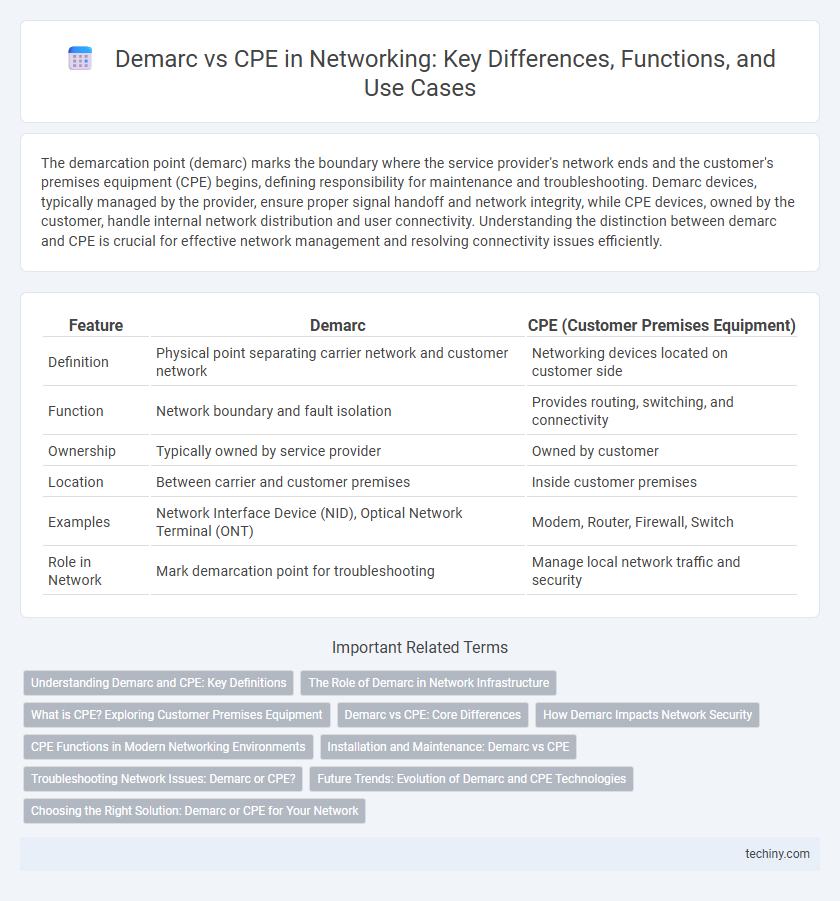The demarcation point (demarc) marks the boundary where the service provider's network ends and the customer's premises equipment (CPE) begins, defining responsibility for maintenance and troubleshooting. Demarc devices, typically managed by the provider, ensure proper signal handoff and network integrity, while CPE devices, owned by the customer, handle internal network distribution and user connectivity. Understanding the distinction between demarc and CPE is crucial for effective network management and resolving connectivity issues efficiently.
Table of Comparison
| Feature | Demarc | CPE (Customer Premises Equipment) |
|---|---|---|
| Definition | Physical point separating carrier network and customer network | Networking devices located on customer side |
| Function | Network boundary and fault isolation | Provides routing, switching, and connectivity |
| Ownership | Typically owned by service provider | Owned by customer |
| Location | Between carrier and customer premises | Inside customer premises |
| Examples | Network Interface Device (NID), Optical Network Terminal (ONT) | Modem, Router, Firewall, Switch |
| Role in Network | Mark demarcation point for troubleshooting | Manage local network traffic and security |
Understanding Demarc and CPE: Key Definitions
Demarc, short for demarcation point, is the physical point in a network where the service provider's responsibility ends and the customer's responsibility begins, often marked by a network interface device. Customer Premises Equipment (CPE) includes all hardware devices--such as routers, modems, and switches--located on the customer's property that connect to the service provider's network at the Demarc. Understanding these definitions is crucial for network management, troubleshooting, and establishing clear ownership boundaries in telecommunications infrastructure.
The Role of Demarc in Network Infrastructure
The Demarc (demarcation point) serves as the critical boundary in network infrastructure, delineating the service provider's responsibility from the customer's equipment, ensuring clear accountability and fault isolation. It acts as the interface where the public network connects to the Customer Premises Equipment (CPE), enabling efficient management and troubleshooting. Properly established Demarc points support seamless integration of network services, enhancing reliability and service quality across enterprise and residential environments.
What is CPE? Exploring Customer Premises Equipment
Customer Premises Equipment (CPE) refers to telecommunications hardware located at the customer's site, including routers, modems, switches, and phones. CPE connects the end-user's network to the service provider's demarcation point, enabling access to internet, voice, and data services. Effective management of CPE ensures optimal network performance, security, and seamless connectivity within residential or business environments.
Demarc vs CPE: Core Differences
Demarc (Demarcation Point) marks the physical boundary where the service provider's network ends and the customer's internal network begins, ensuring clear responsibility division for maintenance and troubleshooting. CPE (Customer Premises Equipment) refers to the devices such as routers, modems, or switches located on the customer's side that connect to the service provider's network at the Demarc. The core difference lies in Demarc being a network boundary and handoff point, while CPE comprises the equipment owned and managed by the customer for network access and functionality.
How Demarc Impacts Network Security
The Demarcation Point (Demarc) serves as the critical boundary where the service provider's network interfaces with the customer's equipment, establishing a clear division of responsibility for network security. By placing security controls and monitoring at the Demarc, organizations can effectively isolate external threats, prevent unauthorized access, and maintain network integrity. This strategic positioning enhances protection against cyberattacks, mitigates risk from compromised Customer Premises Equipment (CPE), and supports consistent enforcement of security policies across the network perimeter.
CPE Functions in Modern Networking Environments
Customer Premises Equipment (CPE) serves critical roles in modern networking environments, including routing, switching, firewall protection, and transmission of data at the network edge. CPE devices enable seamless connectivity between the service provider's demarcation point (Demarc) and end-user devices, supporting advanced functionalities such as network address translation (NAT), Quality of Service (QoS), and VPN termination. Integration of CPE with cloud management platforms enhances remote network monitoring, configuration, and troubleshooting, optimizing overall network performance and security.
Installation and Maintenance: Demarc vs CPE
Demarcation points (Demarc) simplify installation by clearly defining the boundary between the service provider and the customer's network, reducing ambiguity during setup and troubleshooting. Customer Premises Equipment (CPE) requires specialized knowledge and access for installation, as it involves configuring devices located within the customer's site. Maintenance at the Demarc is generally provider-managed, ensuring timely fault isolation, whereas CPE maintenance often depends on the customer's IT staff or contracted technicians, potentially impacting response times and repair efficiency.
Troubleshooting Network Issues: Demarc or CPE?
Troubleshooting network issues often starts at the Demarc (Demarcation Point) because it separates the service provider's responsibility from the customer's premises equipment (CPE). Identifying if a fault exists at the Demarc ensures whether the issue lies within the external network or the internal customer setup. Testing at the CPE helps isolate problems such as configuration errors, hardware faults, or software glitches affecting end-user connectivity.
Future Trends: Evolution of Demarc and CPE Technologies
Demarcation (Demarc) points and Customer Premises Equipment (CPE) are evolving with the rise of software-defined networking (SDN) and network function virtualization (NFV), enabling more flexible and programmable network boundaries. Future Demarc devices will incorporate enhanced security features and support for multi-service edge computing to accommodate IoT and 5G deployments. CPE will shift towards integrated edge platforms with AI-driven automation and cloud-native architectures, improving network performance and management efficiency.
Choosing the Right Solution: Demarc or CPE for Your Network
Selecting the right solution between Demarc and CPE depends on network scale, management control, and service responsibility. Demarc provides a clear boundary point for service provider handoff, ideal for simplifying fault isolation and maintenance, while CPE offers more control and customization at the customer premises. Consider network complexity, technical expertise, and service level requirements to optimize performance and support.
Demarc vs CPE Infographic

 techiny.com
techiny.com